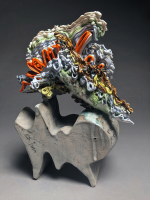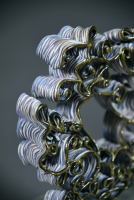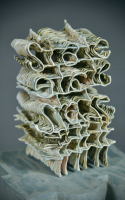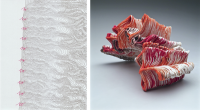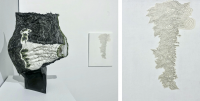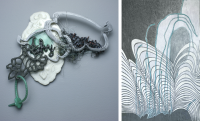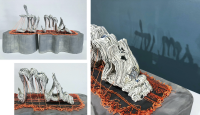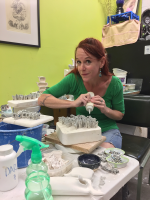Stephanie Lanter is a Kansas-based artist working in clay, fiber, mixed media, and most recently, words. Lanter received a MFA from Ohio University in Athens and currently teaches Ceramics at Emporia State University. She has had residencies at Red Lodge Clay Center, Arrowmont School of Arts and Crafts and the Mendocino Arts Center. As of this writing, you can find her work at Cerbera Gallery in the Kansas City Crossroads District in an exhibition titled "Slippery."
Introduce yourself and describe your work and the media/genre you work in.
Identity is slippery right now for everyone, isn’t it? Once you think you are one thing, you become another. Artists have to be shape-shifters, tricksters in a way to sustain themselves. My name is Stephanie Lanter, and I practice artmaking and educating. I am a twin but single, have been teaching at the university level for twenty years and have been making things and writing since the age of seven. The solo artwork I have exhibited around the world has been primarily abstract ceramic sculpture, but collaboration and explorations of fiber, drawing, mixed media and interaction have also been essential.
After getting my MFA at Ohio University in Athens, I have been lucky enough to have artist residencies around the country at the Red Lodge Clay Center, the Archie Bray Foundation, Arrowmont School of Arts and Crafts, the LH Project, Jentel, Anderson Ranch and the Mendocino Arts Center. I have held teaching positions at Wichita State, Washburn and Emporia State Universities. An array of other institutions and online platforms have graciously hosted my workshops and lectures, and my writings have been featured in journals such as Ceramics, Art and Perception, Ceramics Monthly and more. I was awarded a Kansas Arts Commission Collaboration Grant (the last of its kind!) in 2010 in support of the interdisciplinary Waiting Room Projects, with Marguerite Perret, Bruce Scherting and Robin Lasser.
Currently, I have been investigating the “slippery” condition of language, technology and epistemology through sculpturally manifesting words, phrases and symbols. Utilizing an analog 3-d printing process or manually slip trailing, I trace and obsessively retrace to build ambiguous yet personally significant ‘terms’ with liquid porcelain, facilitating the evolution of virtual thought into visceral object. As in the one-ear-to-another, whispered “telephone game” these works are layered, interrupted, slow journeys and surprising destinations. Perhaps a single phrase can be a dimensional map, poem or even an entire landscape, full of nuance, power and possibility. This newest work is on view now in the exhibition “Slippery” at Cerbera Gallery in the Kansas City Crossroads District, originally awarded as a KC Artists Coalition show.
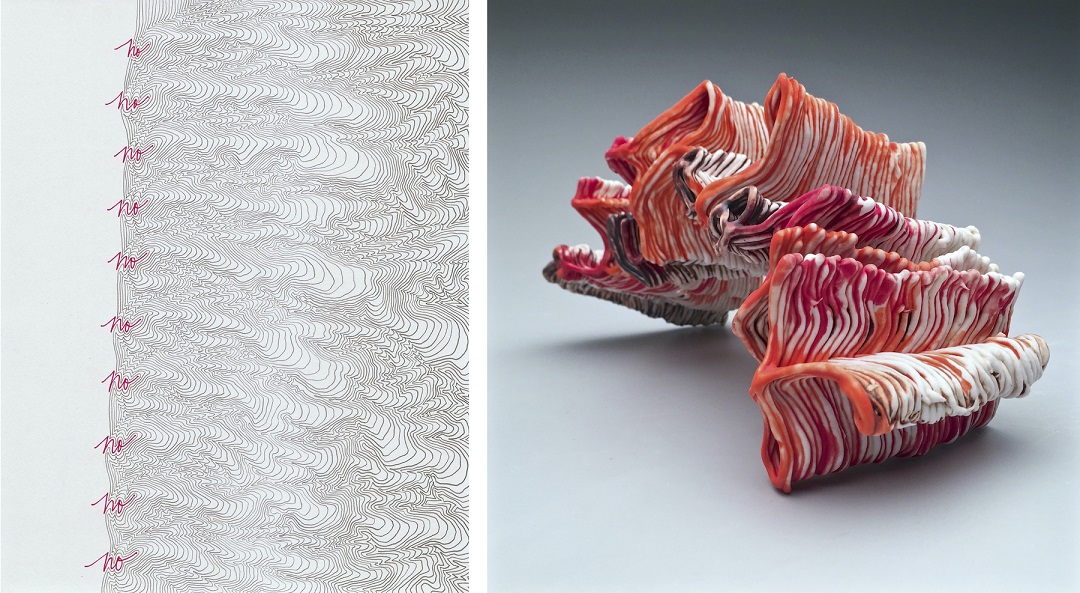
How do your mixed media works come together? Do you have a routine you progress through?
When I begin a piece, sometimes I have a plan and sometimes I don’t. Ceramic processes require a certain amount of rhythm and procedure to arrive at some level of success, but I have never stuck with one mode of working for very long. Mixed media elements might be incorporated/intended from the start, or they might be a solution to a design or conceptual problem later. There are sometimes messages I wish to be legible, like the three words state, state and state in my recent porcelain piece titled as such, as the power of that idea lies in definition and context — “State the state of your state.” In other pieces, such as the sculpture Unsaid, I added wire and thread elements to the porcelain as needed in more of a collage fashion, engaging with the back and forth conversation of the piece rather than following a set of steps. Drawings usually always emerge organically, and even when I think the dialogue is complete, sometimes it nags at me months or years later with new questions. Exhibitions provide a wonderful context for juxtaposing two and three-dimensional pieces in compositions that are revealing and resonant in surprising ways. Discovering these unintended visual and conceptual connections is such a delight.
You often combine fiber work with your ceramic pieces. How did you get started with this? Do you base your fiber work off patterns or do you freestyle?
The first artwork I remember ever making was an apron I determined to sew my Mom for Christmas when I was about seven. I started it in September. Perhaps unconsciously, the first major fiber piece I ever completed in 2002 was also an apron – this time knit, and this time explicitly dysfunctional. Called “Things To Do,” it was six feet wide, and like a tool belt, had ceramic ‘implements’ attached. I designed the pattern for that, and taught myself to crochet by FAILING at following patterns ever since. Some might call me a rule-follower from day to day, but my Art Alter Ego does not work well with rules or templates. Most of the thread and fiber work incorporated with clay or paper in the last 10 years has been intuitive, improvisational and responsive.
I began working with fiber as a reaction to the fragility, heaviness, frustration and immobility of ceramics – I could knit anywhere and it could not break. And it was soothing. Eventually the softness found its way into becoming a sort of skin, crocheted directly onto the clay “pacifier” forms I was making. And then I realized that slip trailing or drawing lines with liquid clay, much like decorating with frosting on a cake, related directly to my love of delicate thread lines and weaving. So I began to build with this linear process to hopefully connect the two mediums more seamlessly.
What is the most challenging thing about your creative process?
At this moment in time, it is difficult to prioritize what to say, as there is so much to consider, and so much judgement, and so much at stake. Generally, however, what I struggle with most are logistics. Getting my fragile, sometimes complicated pieces from point A to point B, whether that is from unfired to fired (in the kiln, for completion) or packing and shipping/delivering to exhibits can be a wrenchingly stressful, laborious, expensive and sometimes a heartbreaking ordeal. One false move or unanticipated shift can mean months of work and hundreds of dollars down the drain when a piece collapses, warps or breaks en-route. When this happens, and it has more than I would like to admit, gallerists on the receiving end are inconvenienced and disappointed as well. Completing a piece to only be stopped violently short of presenting it to the world results in creative constipation and generates in me many questions.
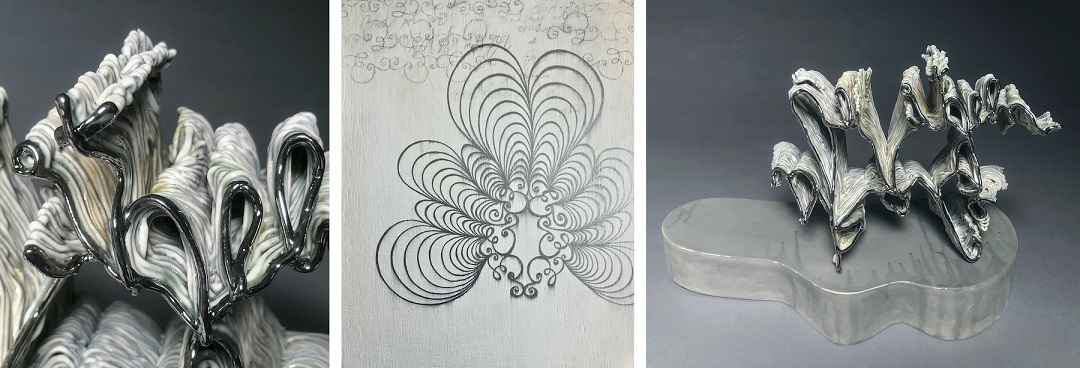
In relation to your art, what is one of the most valuable lessons you have learned during your time as an educator?
Teaching is a constant reminder that the most important skills in artmaking are remembering how to learn, figuring out how to connect and having a confidence that is decisive. As wild as it has been to be charged with teaching topics, I have never been trained in like weaving, woodworking or online ceramics (!) – opportunities like these usually yield skills and concepts that emerge in the work. Completely compartmentalizing or separating personal work and course design seems counter intuitive, but sometimes it takes a while. The core of educating is creating a situation conducive for connections within and between minds, bodies and hearts, and artmaking is the same. Arriving at new intersections of ideas, materials or people is always the magical lightbulb. It will be interesting to see how this moment of acquiring and refining digital skills in photography, design and film will expand the work. I already have ideas for animated drawings.
Additionally, as an introverted person, running a class pushes me to the edge of my emotional comfort threshold time and time again, but over time I have found it to be an essential source of rich recharge and inspiration. Art can’t emerge from a vacuum. Having the gift of creative immersion with not only students, but other colleagues also quite literally saves me from myself.
What areas of your work or personal development are you hoping to explore further?
I have always considered myself a closet poet. Recently I had the nerve to submit a poem for publication in a regional journal, and was excited but terrified to see it accepted. Writing strips one naked. Regardless, I hope above all to grow the poetic potentialities and relevancies of the work to a broader audience, and to gain the courage to dig ever deeper in excavating personal experience in modes both vulnerable and empowering. It’s tough to be really really honest, isn’t it? I recently made a digital sketch: “post truth, post trust, post touch.” It seems necessary to address this sculpturally, in drawing and in words. Merging these approaches is on the horizon.
Books
On Earth We Are Briefly Gorgeous – Ocean Vuong
The Apology – Eve Ensler
The Book of Delights - Ross Gay
A Little Life – Hanya Yanagihara
The Bell Jar - Sylvia Plath
Alone Together – Sherry Turkle
The Edible Woman – Margaret Atwood
Music
Real Life - Joan as Police Woman
You Are Free - Cat Power
Stories of the City, Stories of the Sea - PJ Harvey
A Moon Shaped Pool - Radiohead
Trouble Will Find Me & I Am Easy To Find - The National
Good Souls, Better Angels & Car Wheels on a Gravel Road - Lucinda Williams

